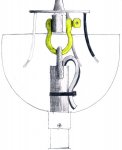PetrosA
Senior Member
- Location
- Lancaster, Pennsylvania
I have a new customer who bought a chandelier from Restoration Hardware. Price tag is around $5k and it's just under 300 lbs with the crystal on't. My job is to install a light lift and hang the chandelier, home run for the chandelier, move some recessed lights out of the way, install eyeball trims etc. on a 17' ceiling. Yesterday went without a hitch, as did today up till 3:30 PM when we unboxed the beast.
It has a mounting kit which the instructions show getting bolted to a joist and a quick link is used to attach the rod to that to hang the light. It turns out the drawing on the instructions is completely out of scale and what they provided is a 1" rigid down rod (which the canopy slips over) with a hook welded to the end of it and absolutely no way to attach the thing to the lowered plate of the light lift. The plate is 3/8" steel, 1.5"x9" or so, and evidently the only way the manufacturer intended the light to hang. There are no threaded fittings like with every other chandelier I've ever hung. The tech guy at Alladin has never seen a mounting means like this. The canopy has a UL sticker on it.
I've come up with a way to attach it to the light lift plate, so that's not a problem. I'm simply curious about whether the standard types of mounting methods using threaded rod and a screw collar loop are a voluntary standard or not, and does the mounting design of this fixture violate anything? I can't imagine how that steel plate and 1" pipe with a hanger welded to it for the quick link can be made to fit through any standard US box to contain the splice (and the chandelier instructions don't mention this at all) without doing some major damage to the box which will also be open on top. Crazy. How can this design be accepted for use in the US with the kind of hardware we use?
It has a mounting kit which the instructions show getting bolted to a joist and a quick link is used to attach the rod to that to hang the light. It turns out the drawing on the instructions is completely out of scale and what they provided is a 1" rigid down rod (which the canopy slips over) with a hook welded to the end of it and absolutely no way to attach the thing to the lowered plate of the light lift. The plate is 3/8" steel, 1.5"x9" or so, and evidently the only way the manufacturer intended the light to hang. There are no threaded fittings like with every other chandelier I've ever hung. The tech guy at Alladin has never seen a mounting means like this. The canopy has a UL sticker on it.
I've come up with a way to attach it to the light lift plate, so that's not a problem. I'm simply curious about whether the standard types of mounting methods using threaded rod and a screw collar loop are a voluntary standard or not, and does the mounting design of this fixture violate anything? I can't imagine how that steel plate and 1" pipe with a hanger welded to it for the quick link can be made to fit through any standard US box to contain the splice (and the chandelier instructions don't mention this at all) without doing some major damage to the box which will also be open on top. Crazy. How can this design be accepted for use in the US with the kind of hardware we use?


